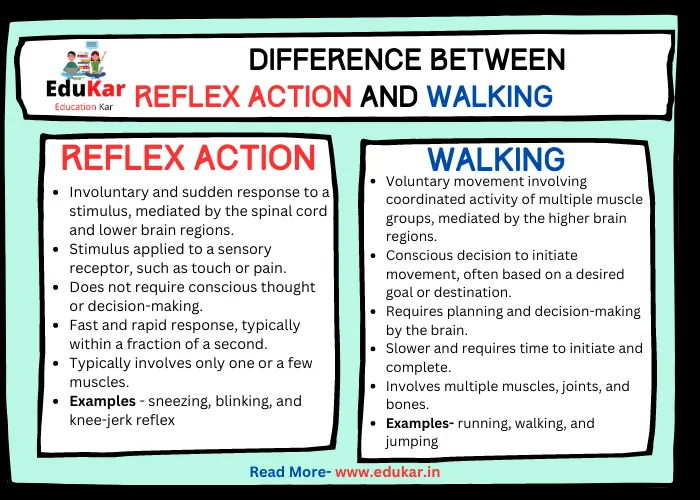Learn about the fundamental differences between reflex action and walking, two important movements performed by the human body. From their nature and purpose to their execution and timeframe, discover the key distinctions between these movements and their underlying mechanisms in this informative blog post.

Introduction
Reflex action and walking are two of the most basic and important movements that humans perform. However, while both involve movement of the body, they are fundamentally different in nature, purpose, and execution. Understanding these differences is crucial for both medical professionals and the general public in order to better comprehend the underlying processes involved in movement and how to manage any issues that may arise.
Reflex Action
Reflex action is a type of involuntary, automatic movement that occurs in response to a stimulus. It is a basic protective mechanism that allows the body to respond quickly to potentially dangerous situations without conscious thought or control. Examples of reflex actions include the knee-jerk reflex and the withdrawal reflex.
The knee-jerk reflex is a common reflex action that occurs when the patellar tendon is tapped with a rubber mallet. This causes the quadriceps muscle in the thigh to stretch, which activates the sensory receptors in the muscle spindle fibers. This sensory information is transmitted to the spinal cord, which then sends a signal back to the quadriceps muscle, causing it to contract and produce the characteristic knee jerk response.
The withdrawal reflex is another common reflex action that occurs when the body experiences pain or a potentially harmful stimulus, such as touching a hot stove. In this case, the sensory receptors in the skin detect the stimulus and send a signal to the spinal cord. The spinal cord then sends a signal to the muscles in the affected limb to contract and move the limb away from the source of the pain.
Characteristics of Reflex Action
Reflex actions have several distinct characteristics that differentiate them from other types of movement:
1. Involuntary – Reflex actions are involuntary, meaning that they occur automatically and without conscious thought or control. This is because they are mediated by the spinal cord and do not involve input from the brain.
2. Quick – Reflex actions are extremely quick, occurring in a matter of milliseconds. This rapid response time allows the body to react to potentially dangerous situations before the brain has had time to process the information.
3. Stereotyped – Reflex actions are stereotyped, meaning that they occur in the same way every time they are triggered. This is because the neural pathways that mediate reflex actions are hardwired and do not allow for variation.
Walking
Walking is a complex, voluntary movement that involves the coordinated action of multiple muscles and the nervous system. It is a fundamental form of locomotion that humans rely on for mobility and independence. Walking requires the integration of sensory information from the environment, as well as feedback from the muscles and joints involved in the movement.
Characteristics of Walking
Walking has several distinct characteristics that differentiate it from reflex action:
1. Voluntary – Walking is a voluntary movement, meaning that it is under conscious control. This allows for greater flexibility and adaptability in response to changes in the environment.
2. Controlled – Walking is a controlled movement, meaning that it requires the coordination of multiple muscle groups and neural pathways. This coordination is necessary to maintain balance and stability during the movement.
3. Complex – Walking is a complex movement that involves the integration of sensory information from the environment, as well as feedback from the muscles and joints involved in the movement. This complexity allows for greater adaptability and flexibility in response to changes in the environment.
Components of Walking
Walking involves the coordinated action of several different components, including the muscles, nervous system, and brain:
Muscles – Walking requires the coordinated action of multiple muscle groups, including the legs, hips, and core muscles. These muscles work together to produce the coordinated movement of the body during walking.
Nervous System – The nervous system plays a critical role in walking, including the integration of sensory information from the environment, as well as feedback from the muscles and joints involved in the movement. The spinal cord and brain play a central role in coordinating the movement of the muscles involved in walking.
Brain – The brain plays a critical role in walking, including the integration of sensory information from the environment, as well as the control and coordination of the muscles involved in the movement. The cerebellum and basal ganglia are particularly important brain regions involved in walking.
Examples of Walking
Walking can take many different forms and can be used for a variety of purposes. Some examples of walking include:
Strolling – Strolling is a relaxed form of walking that is typically done at a leisurely pace. It is often used for relaxation, exercise, or socialization.
Speed Walking – Speed walking is a more intense form of walking that involves walking at a brisk pace. It is often used for exercise and can be a competitive sport.
Power Walking – Power walking is a high-intensity form of walking that involves swinging the arms and using more forceful strides. It is often used for fitness and can be a competitive sport.
Differences Between Reflex Action and Walking
| S.No. | Reflex Action | Walking |
|---|---|---|
| 1. | Involuntary and sudden response to a stimulus, mediated by the spinal cord and lower brain regions. | Voluntary movement involving coordinated activity of multiple muscle groups, mediated by the higher brain regions. |
| 2. | Stimulus applied to a sensory receptor, such as touch or pain. | Conscious decision to initiate movement, often based on a desired goal or destination. |
| 3. | Does not require conscious thought or decision-making | Requires planning and decision-making by the brain |
| 4. | Fast and rapid response, typically within a fraction of a second | Slower and requires time to initiate and complete |
| 5. | Typically involves only one or a few muscles | Involves multiple muscles, joints, and bones |
| 6. | Examples include sneezing, blinking, and knee-jerk reflex | Examples include running, walking, and jumping |
| 7. | Controlled by the spinal cord and lower brainstem | Controlled by higher brain centers, including the cerebellum and motor cortex |
| 8. | Not affected by emotions or conscious thought | Can be affected by emotions and conscious thought |
| 9. | Does not require learning or practice | Requires learning and practice to develop proper technique and efficiency |
| 10. | Usually cannot be stopped or prevented once initiated | Can be stopped or prevented at any time by the brain or external factors |
Summary
Reflex action and walking are two fundamental movements that humans perform. While both involve movement of the body, they differ in nature, purpose, and execution. Reflex action is an involuntary, automatic movement that occurs in response to a stimulus, while walking is a voluntary, controlled movement that is initiated by the individual. Reflex action is quick and stereotyped, while walking is complex and requires the integration of sensory information and feedback from the muscles and joints involved in the movement.
Understanding these differences is crucial for both medical professionals and the general public in order to better comprehend the underlying processes involved in movement and how to manage any issues that may arise. Further research into these topics can help us to better understand the mechanisms behind these movements and improve our ability to manage and treat any issues that arise.
FAQs
What is a reflex action?
A reflex action is an involuntary and immediate response to a stimulus. It is controlled by the spinal cord and does not involve conscious thought.
What is walking?
Walking is a voluntary movement that involves the coordination of muscles and is controlled by the brain. It requires conscious thought and planning.
What is the main difference between reflex action and walking?
The main difference between reflex action and walking is that reflex actions are involuntary and immediate responses to a stimulus, while walking is a voluntary movement that requires conscious thought and planning.
How is reflex action controlled?
Reflex action is controlled by the spinal cord.
How is walking controlled?
Walking is controlled by the brain, specifically the motor cortex, which coordinates the movement of muscles in the legs and feet.
Can reflex action be consciously controlled?
No, reflex action cannot be consciously controlled. It is an automatic response to a stimulus.
Can walking be performed unconsciously?
Yes, walking can be performed unconsciously, such as when a person is sleepwalking.
Are reflex actions and walking mutually exclusive?
No, reflex actions and walking are not mutually exclusive. In fact, reflex actions can sometimes occur during walking, such as when a person involuntarily steps on a sharp object.
Are reflex actions and walking equally important?
Both reflex actions and walking are important for the body. Reflex actions protect the body from harm, while walking is important for mobility and overall health.
Can reflex actions and walking be improved or trained?
Reflex actions cannot be consciously improved or trained, as they are an automatic response. However, walking can be improved through practice and training, such as physical therapy or exercise.






